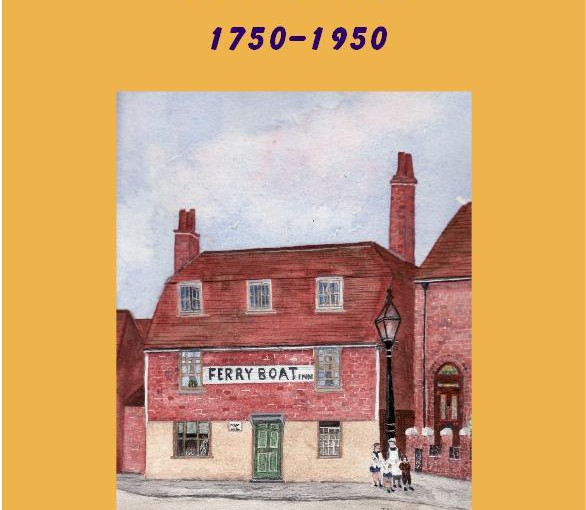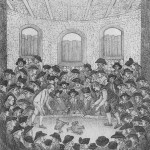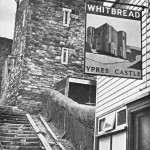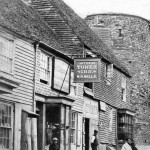East Sussex, 1750-1950 by David Russell
Published in October 2012 The Pubs of Rye gives the history of 32 Rye pubs (and one cinema) which existed at sometime between 1750 and 1950. When researching this book I collected information from the National Archive which contains many records of Rye and its licensed premises.Deep in the archive lie hundreds of vouchers – some dating back to the 1650s – which were issued to Rye landlords by the town Corporation. These vouchers were payments for hospitality provided to customers who had served the corporation in some way. They include builders employed on public works, bell ringers, men firing the guns in the Gun Garden and jurors attending Coroner’s Inquests.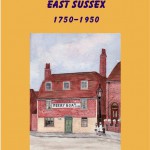
I have also scanned 120 years of local newspapers where I found a vast amount of information dating back to the 1750s. Indeed, on second thoughts this book should be dedicated to the journalists of yesteryear who have left us with so many excellent reports of pub life.
‘Frenchie and the Hoppers’, for example, is a wonderful account of hop pickers drinking in the Bedford Arms in the 1870s, or the ‘Lady Swindler’ who visited Rye one day in 1875 and quickly became the main topic of conversation in the bars of the Cinque Ports Arms and the Crown.
A LADY SWINDLER.—On Tuesday last, a rather handsomely-attired female, about 35 years of age, was driven by a Hastings flyman into Rye, and on her arrival she made inquiries at the Custom House for the French Consul, and produced some papers purporting to relate to some property belonging to her. Being informed the Collector had just left with the Superintendent of police, which was a rather singular coincidence, she took her departure, promising to call again, and in the meantime she drove to the Cinque Ports Arms and had some refreshment, not forgetting to entertain the driver, whom she afterwards prevailed upon to lend her 10s to enable her to make a few small purchases. She afterwards left the hotel alone, without paying the score, but stating that she should return to tea after transacting some business.
But instead of that she went to the Crown Inn, and hired a conveyance to take her to some friends at Winchelsea, stating that she was an invalid and unable to walk that distance, as she was one of the sufferers in the Shipton railway accident. On arriving at Winchelsea, she did not pay any visits, but directed the man in charge to drive to the railway station, as she was expecting some one by the next train. She then paid for the hire of the vehicle and dismissed the man, not forgetting to give him something for himself.
In the evening, the flyman began to get rather disconsolate at finding his fare did not return to the Cinque Ports Arms at the appointed time, and he instituted inquiries, calling at the Crown Inn, where he learned that a female answering the description had been taken to Winchelsea. After receiving this unwell come intelligence he returned to Hastings, minus 10s. and his day’s pay. The last tidings of the ‘lady’ were that she took a ticket at Winchelsea station for Ashford, and although the police have been put upon the qui vive, it is doubtful whether she will again visit this neighbourhood.
I have also uncovered some long forgotten licensed premises which until now have been ‘hidden from history’. The Dial in the High Street, Henry Huggett’s Beer House and the Cock and Coney (now the Ship), are examples which come to mind. Likewise some long forgotten pub games such as Bat and Trap (played in the Ypres Castle Inn and Queen Adelaide), Kick up Jenny (Ferry Boat), Spinning Jenny and the Wheel of Fortune (Foresters and Red Lion), and quoits which was played all over the town but particularly behind the Crown. Two other pastimes were the Kentish sport of Goal Running with the Rye town team based at the Queens Head, and the notorious ‘sport’ of cock fighting and its associated gambling at the George Inn in the 18th century.
This history is supported by five appendices, providing information on the local friendly societies, the Rye temperance movement, the Treating Scandal of 1852, mock mayor elections in the nineteenth century and a register of licensees of 59 public houses known to date.
The book is illustrated with around 100 photographs many from the archive of John Hodges. The watercolour of the Ferry Boat Inn on the front cover is by Jean Hope and shows the pub prior to 1898. The book is in paperback, 282 pages, price £13.99, and can be purchased at Adams of Rye, the Rye Heritage Centre, the Martello bookshop and at Waterstones in Hastings. It is also available from the publisher, Lynda Russell at [email protected], phone 01424 200227.
I welcome contributions of Rye pub memories for inclusion in any future re-print.
From the November 2012
All articles, photographs and drawings on this web site are World Copyright Protected. No reproduction for publication without prior arrangement. © World Copyright 2016 Cinque Ports Magazines Rye Ltd., Guinea Hall Lodge Sellindge TN25 6EG
